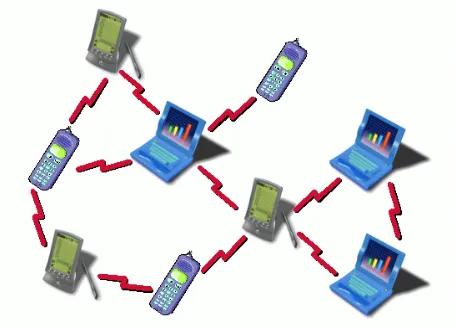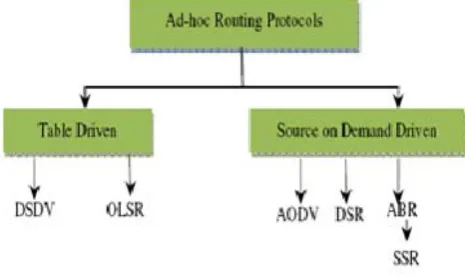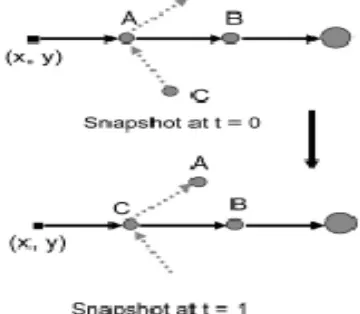Reducing End to End per Packet Energy
Consumption
N.Annapurna#1,M.V.Vijaya saradhi *2 #
PG Scholar, Department of IT, Aurora’s Engineering College, Bhongir, Andhra Pradesh, India
#
HOD, Department of IT, Aurora’s Engineering College, Bhongir, Andhra Pradesh, India
Abstract—A mobile ad-hoc network (MANET) consists of
mobile nodes which cooperate in forwarding information in mobile ad-hoc network. In this paper we focus mainly on the end to end per packet energy consumption. We first find the destination address in the network, find all the possible paths to reach the destination, select the shortest path to send the information, calculate the energy required to send the information from source to destination and calculate time to send. We take coherence time as maximum time for which end to end quality of service remains constant and spreading period as minimum time to spread information to all the nodes and finally we show a graph.
Keywords— Wireless, mobile, network, MANET, energy.
I. INTRODUCTION
A mobile ad-hoc network is a group of mobile nodes which can move from one place to other, mobile node can be any electronic device a person can carry from place to place like cell phones, PDA, laptop or pager etc [2][9].
Fig 1.1: Mobile Ad Hoc Network
In mobile ad hoc network routing is challenging problem from past few years. Routing is the act of moving information across an inter-network from a source to a destination. Along the way, at least one intermediate node typically is encountered. It’s also referred to as the process of choosing a path over which to send the packets. In MANET each mobile node can send information to other node at any point of time by using intermediate nodes. In ad-hoc networks all nodes are mobile and can be connected dynamically in an arbitrary manner.
A Mobile Ad-hoc Network (MANET) is a collection of wireless mobile nodes forming a temporary network without using any existing infrastructure or any administrative support [1]. The wireless Ad-hoc networks are self-creating, self-organizing and self- administrating [8]. The nodes can function as routers, which discovers and maintains routes to other nodes [7].
The Ad-hoc network may be used in emergency search-and-rescue operations, battlefield operations and data acquisition in inhospitable terrain. In Ad-hoc networks, dynamic routing protocol must be needed to keep the record of high degree of node mobility, which often changes the network topology dynamically and unpredictably Ad-hoc network presented on fig1.2.
Fig1.2: Example of an Ad Hoc Network
II. ROUTING PROTOCOLS
In order to facilitate communication within a network, a routing protocol is used to discover routes between nodes. The primary goal is routing protocol is correct and efficient route establishment between a pair of nodes so that message may be delivered in a timely manner.
The existing routing protocols in MANETs can be classified into two categories: (1) Table-driven routing protocols, and (2) on-demand routing protocols [1]. Fig 2.1 shows the classification along with some examples of existing MANET protocols. In this paper we take DSDV routing protocol to establish route between the mobile nodes.
Fig 2.1: Classification of MANET’s routing protocol
A. OVERVIEW OF DSDV ROUTING PROTOCOL
Destination-Sequenced Distance Vector DSDV is
one of the most well-known table-driven routingalgorithms for MANETs The Destination-Sequenced Distance-Vector (DSDV) Routing Algorithm is based on the classical Bellman-Ford routing algorithm with certain improvement [3]. Every mobile station maintains a routing table with all available destinations along with information like next hop, the number of hops to reach to the destination, sequence numberof the destination originated by the destination node, etc.DSDV uses both periodic and triggered routing updates tomaintain table consistency.
Triggered routing updates are used when network topology changes are detected, so that routinginformation is propagated as quickly as possible. Routing tableupdates can be of two types - "full dump" and “incremental”. “Full dump” packets carry all available routing information and may require multiple network protocol data units (NPDU); “incremental” packets carry only information changed since the last full dump and should fit in one NPDU in order to decrease the amount of traffic generated [4].
Periodically transmit Mobile nodes cause broken links when they move from place to place. When a linkto the next hop is broken, any route through that next hop is
mobile node other than the destination node assigns the sequence number. Sequence numbers assigned by the origination nodes are evennumbers, and sequence numbers assigned to indicate infinitymetrics are odd numbers. When a node receives infinity metric, and it has an equal or later sequence number with a finite metric, it triggers a route update broadcast, and the routewith infinity metric will be quickly replaced by the new route. When a mobile node receives a new route update packet; it compares it to the information already available in the table and the table is updated based on the following criteria:
If the received sequence number is greater, then the information in the table is replaced with the information in the update packet. Otherwise, the table is updated if the sequence numbers are the same and the metric in the update packet is better.
The metrics for newly received routes are each incremented by one hop since incoming packets will require one more hop to reach the destination. In an environment where many independent nodes transmit routing tables asynchronously, some fluctuations could develop. DSDV also uses settling time to prevent fluctuations of routing table updates. The settling time is used to decide how long to wait before advertising new routes.
The DSDV protocol guarantees loop-free paths to each destination and detects routes very close to optimal. It requires nodes to routing update packets. These update packets are broadcast throughout the network. When the number of nodes in the network grows, the size of the routing tables and the bandwidth required to update them also grows, which could cause excessive communication overhead. This overhead is nearly constant with respect to mobility rate.
III. ASSUMPTION
We shall constrain ourselves in this paper to the single base station where each mobile node can send information to the base station. Assume that there are 10 mobile nodes, and each node generates message at an average rate of 100 kilobytes per hour, each packet is 1 kilobyte, and must be transferred to the base station with in 5s.assume that every node has a energy of AAA battery. And assume that each node moves with same speed.
Each user wants to send information to the base station possibly by using the other nodes in the mobile network as relays. Examples of application scenarios for this setting are
2) Scientists in the forest who make measurements to be relayed quickly to the laboratory collection site for analysis.
3) Emergency rescue teams in a disaster area who send critical information to the disaster management headquarters.
Our main idea is illustrated in fig. 3.1, assume that our aim is to transfer information from location (x,y) to a fixed base station BS. Assume that in snap shot t=0, the intermediate nodes are A and B, and in snapshot t=1, node C moves in A’s place and if no node is replaced. In such a case, reactive routing protocols would say that the original path has been broken. Proactive routing protocols would welcome this, here, our main idea is that the relay nodes in between are interchangeable. When sending information from (x,y) to BS, the source node would not care who relays the information, but rather care that the message delivered on time or not. The figure shows the instantaneous path construction from (x,y) to BS at snapshot t=0. At snapshot t=1, the flock of nodes replace by another flock of nodes that moves away , but it has been replaced by another flock of nodes roughly in its place, such that density of the nodes in between has remained the same.
Fig 3.1: Instantaneous path
Our main idea is to focus on the energy metric and show a graph. We define the “coherence time” of this graph as the maximum duration for which the map remains roughly constant. If the nodes can jointly construct this energy map and spread it among themselves within this coherence time, then the energy map can be used to give each node, per-packet end to end energy consumption guarantees that are valid. We define the “spreading period” as the minimum duration required to jointly construct and spread the energy field to all of the nodes.
Hence, if the coherence time of the graph islarger than the spreading period, then we have a mobile network for which the energy metrics can be tracked.
In practice, the mobile nodes cannot “sample” the end to end energy potential because an end-to-end measurement from each mobile node i to BS would be needed. Such measurements, even if initiated, can only be collected by BS. However, the nodes themselves would need these measurements to construct the energy potential. Our main idea is to have each node measure the energy field, which is a locally determinable quantity, and exchange these measurements such that each node can estimate the energy field accurately, from which it can construct the parts of the energy potential that it needs.
As a preliminary step, assume that the local measurements of the energy field were exchanged instantaneously with all of the nodes in the network. The main idea is that if a node had access to the database of all of the local measurements of the energy field made by all of the nodes, the node looks up the estimate of the energy field from the database. Based on this estimate, it constructs the first hop of a “path”. After this first hop to reach the destination, we arrive at a point next node. We repeat the procedure by following the energy field, until the path ends at the base station.
IV. SIMULATION RESULTS
A. SERVER
The receiver of request which is send by client is known as server. It is a process that serves the client requests. Set the destination IP address and select the file and send to client. Characteristics of server are waits for request from clients does not interact directly with end users usually accepts connections from a large number of clients.
B. REDUCING END TO END PER PACKET ENERGY CONSUMPTION
To select the shortest possible route for each router calculate the energy used to deliver the packet to destination and time spend and generate the graph for Coherence time vs spreading period [6].
C. CLIENT
The request sender is known as client. It is a process (program) that sends a message to a server process set receiving path, Characteristics of client initiates requests waits for and receives replies interacts directly with end users using graphical user usually connects to a small number of servers at one time.
In simulation results we are taking source and destination as client and server, initially we have to select the receiving path that is nothing but a destination, then server send the file to client. We are ad hoc network with 15 mobile nodes, any node can send information to any node, after selecting the source and destination shortest will be selected to send the information.
Here green nodes is the path used to send the information and blue node show that transmission is failed because of nodes changing the place. Then the packet size and energy required to send the information and time will be displayed.
Finally we show a graph.
V. CONCLUSION
In ad hoc network to establish route we use DSDV routing protocols, then we find the shortest path in the network by using energy field calculated by each node, so that energy and time utilized to send the information will be less. Finally we show a graph.
VI. REFERENCES
[1] James F. Kurose, Keith W. Ross, “Computer Networking, A Top – Down Approach Featuring the Internet”, Second Edition, Pearson Education.
[2] Analysis of Adhoc on demand Distance Vector Routing Protocol," ICIS 2009, vol. II, pp. 610- 614, November 2009.
[3] Valid Nazari Talooki, Jonathan Rodriguez, "Quality of Service for Flat Routing Protocols in Mobile Ad-hoc Network," ICST, September 7-9, 2009.
[4] V. Ramesh, Dr. P. Subbaiah, N. Koteswar Rao and M. Janardhana Raju, "Performance comparison and analysis of DSDV And AODV for MANET," ( JJCSE) International Journal on Computer Science and Engineering, vol. 02, pp. 183 188, 2010.
[5] Charles E. Perkins, Elizabeth M. Belding-Royer, Samir R. Das “Ad hoc On-Demand Distance Vector Routing”,
IEFT MANET Draft, Charles E. Perkins, Ad Hoc
[6] M.K. Park and V. Rodoplu, “Energy Maps for Large-Scale, Mobile Wireless Networks,” Proc. Int’l Comm. Conf. (ICC ’07), pp. 3136-3141, June 2007.
[7] S. Chakrabarti and A. Mishra, “QoS Issues in Ad Hoc Wireless networks,” IEEE Comm. Magazine, pp. 142-148, Feb. 2001.
[8] A. Iwata, C.-C. Chian, G. Pei, M. Gerla, and T.-W. Chen, “Scalable Routing Strategies for Ad Hoc Wireless Networks,” IEEE Trans. J.Selected Areas in Comm., vol. 17, no. 8, pp. 1369-1379, Aug. 1999.
[9] C. Zhu and M.S. Corson, “QoS Routing for Mobile Ad Hoc Networks,” Proc. IEEE INFOCOM, pp. 1488-1505, Aug. 2002.
1. N.Annapurna1 PG Scholar, Department of IT, Aurora’s Engineering College, Bhongir, Andhra Pradesh, India.
2. Dr.M.V.Vijaya Saradhi received his Ph.D degree from Faculty of Engineering, Osmania University (OU), Hyderabad, Andhra Pradesh, India. He is Currently Working as Professor in the Department of Information Technology (IT) at Aurora's Engineering College, Bhongir, Andhra Pradesh, India. His main research interests are Software Metrics, Distributed Systems, Object-Oriented Modeling, Mobile Environment, Data Mining, Design Patterns, Object- Oriented Design Measurements and Empirical Software Engineering. He has Published more than 20 Research Papers in the International Reputed Journals. He is a life member of various Professional bodies like MIETE, MCSI, MIE, MISTE. Contact him at
meduri_vsd@yahoo.co.in


